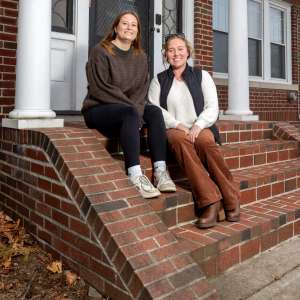Environmental Studies and Geography Team Up to Study Air Pollution in Keene, NH

Normally one wouldn’t associate the study of geography with the study of respiratory illness, but in Keene there is a surprising link that is being uncovered by a partnership between the Environmental Studies and Geography departments and the city of Keene.
Community GIS (geographic information system) Coordinator and Keene State graduate from Dover, NH, Samantha Gaudette ’15, is one of the members of the Geography Department working on analyzing the real-time air quality data collected by Environmental Studies professor, Dr. Nora Traviss, and her research associates over the last few years.
“Keene is a valley and what that means topographically is that it’s essentially a bowl. And on calm, cool winter nights what happens is called an air inversion. There’s this mix of air pollution from wood smoke, car exhaust and whatever else is in the atmosphere—so rather than just blowing right over us, because of the air inversion, a pocket of polluted air is pushed down into Keene. It’s really not a good situation for children, older people and people with breathing issues,” said Gaudette.
While this issue is not particularly visible in the city, Dr. Traviss and her team has collected enough data to prove that there is a real threat to the health of the population, especially those with compromised health already.
“It’s surprising since you wouldn’t assume that burning something natural would be a problem. What Dr. Traviss and her researchers discovered was that the pollution is very localized to certain neighborhoods. They found this out by driving a car retrofitted with air quality sensors from 1 to 3 a.m. in Keene at the height of the air pollution and captured this data,” said Gaudette. “The particles that are in the air that are most prevalent are called particulate matter 2.5, which means that it’s particulate matter from the burning of the wood—all that dust and dirt and soot that’s spitting up into the air. Particulate matter 2.5 is so small that it can get into your bloodstream through your lungs.”
While the research began with the Environmental Studies Department, it has since expanded to include work by Dr. Chris Brehme and the Geography department. What the latter brings to the table is ways to better assess why some parts of the city see higher levels of the dangerous particulates than others. Gaudette’s job includes taking the data collected by Traviss and creating a visual representation of the information showing the most heavily affected areas of the city.
“Dr. Traviss and Dr. Brehme identified early on that they need better education and outreach materials. One of the things that they’re doing is sponsoring an air quality workshop here on campus that will educate people on this issue, and survey to see what people know,” said Gaudette. “They also want people to understand that if they live in one of the affected areas and they’re one of the sensitive populations or know someone who’s one of the sensitive populations, they’re at a real health risk.”
Gaudette, a graduate from the Geography Department has been charged with creating the materials for the outreach session. The idea of visually representing the data for the Keene community is to strengthen the message that there is a very real health risk facing parts of Keene.
“Dr. Traviss and Dr. Brehme approached me and asked me if I would be interested in developing some of the materials. So as part of my research with them, I’ve been developing the survey they will use at the workshop, which aims to determine peoples’ heating behaviors, what motivates their choice in heating sources and how that affects the way they would respond to something like an air quality advisory,” said Gaudette.
Once the outreach session is complete, the information from the surveys will be complied and analyzed to develop a number of research questions that can be answered through topographic analysis of Keene in order to better inform the measures that can be taken to lower the amount of air pollution in the city.





